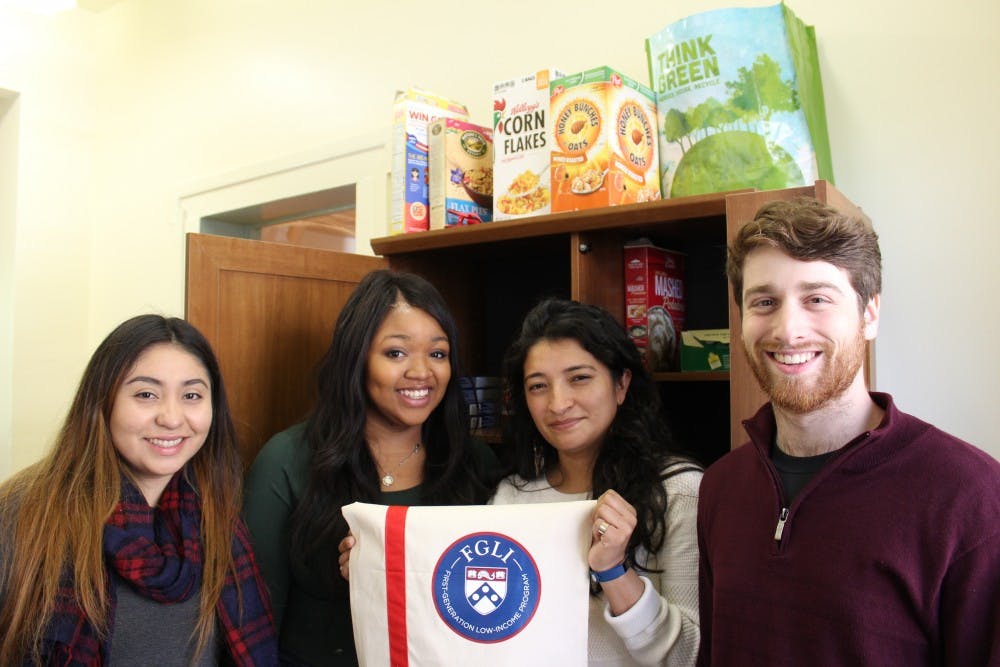Until last semester, Penn First thought that opening a center for first generation, low income students would take 10 years.
FGLI students at Brown University took eight years to negotiate for a center and leaders of Penn First were anticipating a similar timeline. But on Thursday, just a year since Penn First was formed, members will attend the opening of a campus FGLI Center — the second of its kind among Ivy League universities.
Housed in the Greenfield Intercultural Center, the FGLI Center consists of two rooms: a lounge for students and an office for two staff members recruited over the summer to coordinate the FGLI program that began this semester and includes initiatives such as a donation-based food pantry and textbook library where FGLI students can take out resources for free.
The GIC has a history of working with FGLI associated groups, which made it a natural option for Penn First when they considered locations for the FGLI center.
“The GIC is an incubator,” said GIC Director Valerie De Cruz. “Many of the resources on campus supporting diversity, including the three cultural centers, all started here. The FGLI program is how we continue to support emerging communities.”
At 5 p.m. on Thursday, Provost Vincent Price and Vice Provost for University Life Valarie Swain-Cade McCoullum will oversee the ribbon-cutting ceremony for the FGLI center.
Penn First launched officially in the fall of 2015. In the spring semester of 2016, the group reached out to Penn’s administration for support, receiving more than 150 responses from staff and faculty, many of whom indicated that they were formerly FGLI students. Some of these conversations grew into actual programs such as the Library Resource Liaisons program proposed by staff at Penn Libraries. Under this program, four FGLI students are given work-study positions where they train to become library resource liaisons for other FGLI students.
During the spring semester, Penn First began meeting with high level administrators to articulate the infrastructural support they wanted for FGLI students. In April, they met with Cade, asking for a program budget. Two weeks later, she verbally confirmed that a FGLI program budget had been approved and plans for a FGLI center were underway.
“I can’t express how it felt for us to be heard by important administration,” said College sophomore Anea Moore who was present at the second meeting. “[FGLI students] are used to having to solve our own problems... so it felt really, really great that someone was finally trying to help us.”
For members of Penn First, having a physical center to call their own is important on many levels.
As a place that can be “radically different” from the neighborhoods where FGLI students grew up in, the center provides a point of contact for students and particularly freshmen seeking help and solidarity, said College junior Jeffrey Arango, one of the 11 co-founders of Penn First.
Nursing senior Mary Marquez agreed. Even while schools have increased recruitment of FGLI students, “It’s one thing to be able to pay for school and another thing to be able to live in a community like Penn,” she said.
For College senior Juana Granados , the center is symbolic of the presence that FGLI students occupy on a campus that did not traditionally include them.
“If you walk around campus, you don’t see a lot of FGLI footprints,” said Granados, who is a co-founder of Penn First. “The fact that we have a space means that our community has a legacy on this campus and our community has made our mark.”
New initiatives under the FGLI program such as the center and the food pantry are not just meaningful for current students but for FGLI Penn alumni, Granados said. When she told her FGLI alumni mentor who graduated from Penn in 1985 about the new FGLI program, he started tearing up.
“[Having a program and center] means a lot to alumni because these were things that were very far off for a very long time,” said Associate Director for Recruitment at the Center for Programs in Contemporary Writing and 2005 College graduate Jamie-Lee Josselyn .
“This was not just because of institutional limitations but because the students themselves did not always identify as FGLI,” added Josselyn, known as a “Penn First mum.”
Yet, even while people celebrate the grand opening of the FGLI center today, 2016 College graduate Cheyenne Rogers said she hopes students recognize the work that went into creating this space.
“This is a space that didn’t necessarily have to exist and wouldn’t have existed without FGLI students putting time and work into it,” Rogers, who is a co-founder of Penn First, said.
One reason the FGLI program took off so quickly is that there is now a critical mass of FGLI students at Penn, Cade said. Twelve percent of the Class of 2019 are first generation. She added that the process was accelerated because leaders of Penn First were clear, consistent and practical about their needs.
“We worked at [Penn First] like it was our second job. Or our third or fourth in the case of some people,” Granados said.
Granados added that Cade, among other administrators, was crucial in pushing for the center. Cade was the first in her immediate family to attend college and said she experienced many of same difficulties that FGLI students raised during their meetings with her.









